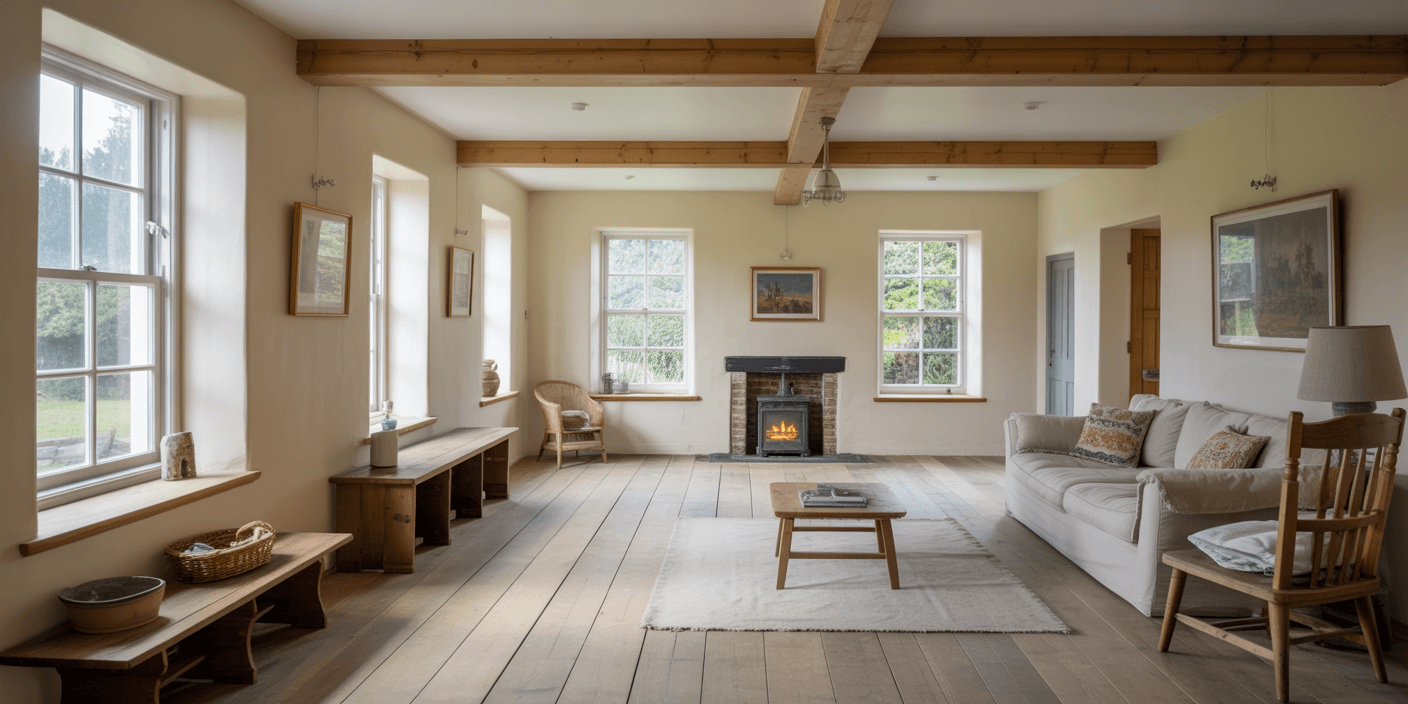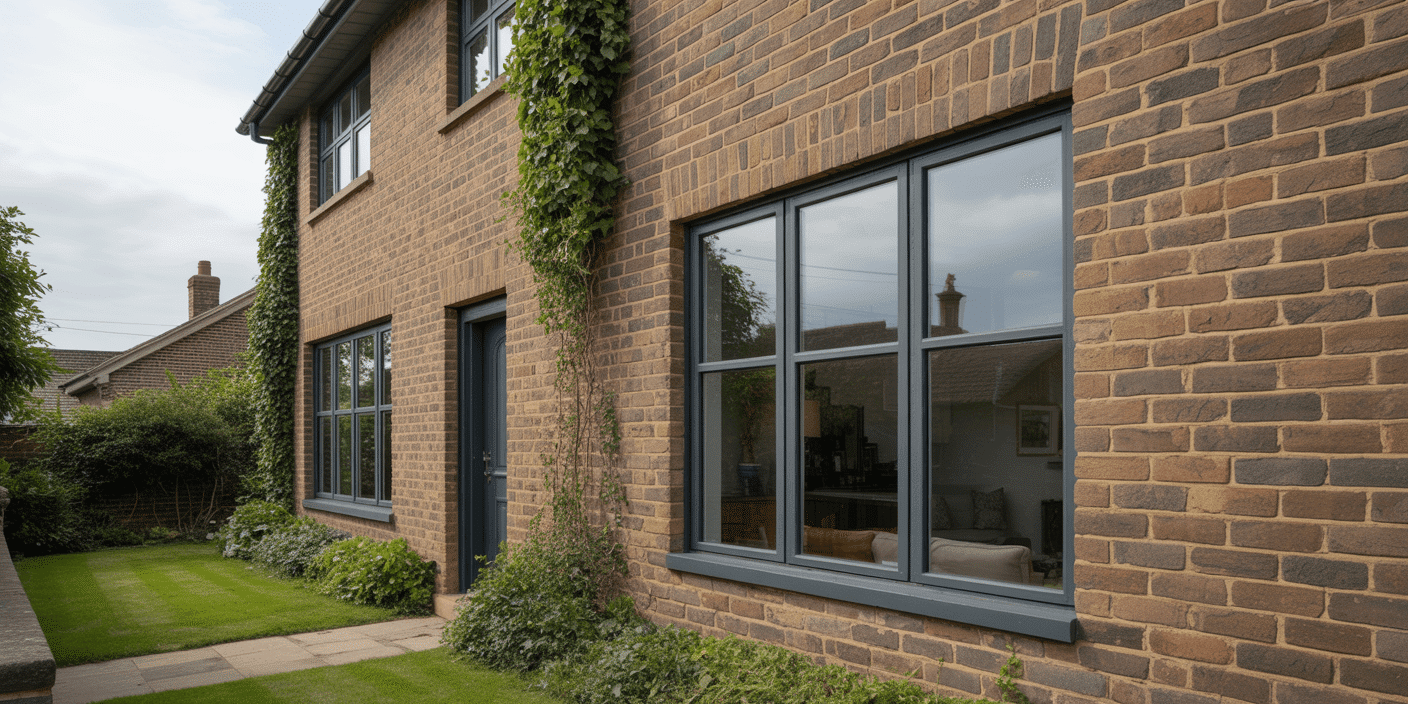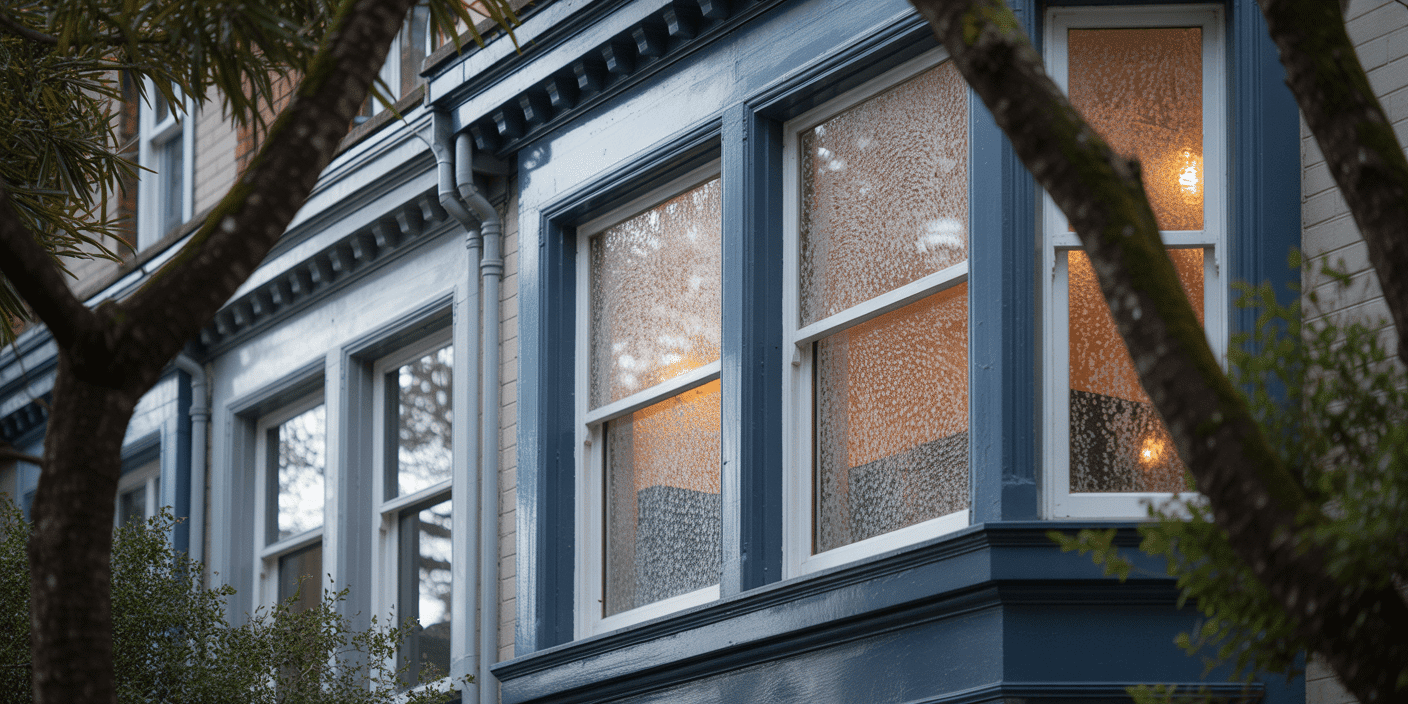The Silent Thief in Your Home
You wake to a familiar contradiction: the heating is on, the radiators warm, the boiler engaged — and yet, the room remains uncomfortably cold.
It isn’t the thermostat. It’s not a faulty system.
It’s your windows.
While attention is often paid to decorative finishes — repointed brickwork, designer kitchens, curated colour palettes — a far more critical issue is quietly undermining your home’s efficiency: thermal loss through substandard glazing.
Contrary to popular belief, the absence of draughts or visible leaks does not mean your windows are performing well. In fact, the most costly inefficiencies are often invisible — a steady, silent loss of heat through the glass, frames and seals that continues unabated throughout the colder months.
This is the U-value problem — and in thousands of premium homes across the UK, it marks the difference between true comfort and an annual energy loss of up to £850 or more.
You wouldn’t tolerate a leaking pipe.
So why accept leaking heat?
What Exactly Is a U-Value (And Why It Matters)
Let’s get technical—but keep it simple.
A U-value measures how well a building element — like a window — resists heat loss. Specifically, it calculates the rate at which heat passes through one square metre of a material for every degree of temperature difference between inside and outside. The units are W/m²K (watts per square metre per degree Kelvin).
Translation?
The lower the number, the better your windows are at keeping the heat in — and the cold out.
✅ Here’s the baseline:
| Glazing Type | Typical U-Value (W/m²K) |
| Single Glazed Sash | 4.8–5.8 |
| Early Double Glazing | 2.6–3.0 |
| Modern Double Glazing | 1.2–1.4 |
| Triple Glazing | 0.8–1.0 |
| Passive/Composite Units | As low as 0.6 |
Most period homes across the UK still operate with windows pushing 3.0 to 5.0 W/m²K — which is like trying to boil a kettle with the lid off, in a gale.
And that’s not just poor efficiency. It’s actively working against your heating system, forcing it to over-perform and over-consume — just to maintain basic comfort.
This is why regulations like Part L of the Building Regulations now require new and replacement windows to have U-values of 1.4 or better. And it’s why modern glazing, engineered with thermal breaks, low-E coatings and gas-filled units, is becoming the new standard for legacy homes—without sacrificing character.
The U-value isn’t just a number.
It’s the thermal fingerprint of your home’s biggest heat escape route.
And ignoring it? That’s like paying to heat the garden.
Real Data, Real Money — How Much Heat (and Cash) You’re Losing

If your windows could talk, they’d be screaming.
Because behind every decorative Georgian frame or well-maintained timber casement, there’s a number—your U-value—that determines just how fast your home loses heat. And when that number is too high, the impact isn’t abstract. It’s directly visible on your energy bills.
Let’s break it down.
The average UK household uses around 17,000 kWh of energy per year. Windows typically account for 15–25% of that loss, depending on age and glazing type.
Now assume you’re paying 25p per kWh (and many are paying more). Here’s what your window system could be costing you annually:
| Window Type | Typical U-Value | Estimated Heat Loss | Annual Cost (@ £0.25/kWh) |
| Single Glazing | 5.0 | ~3,400 kWh | £850 |
| Old Double Glazing | 2.8 | ~2,000 kWh | £500 |
| Modern Double Glazing | 1.4 | ~1,100 kWh | £275 |
| Triple Glazing | 0.8 | ~650 kWh | £162.50 |
| Passive Units | 0.6 | ~500 kWh | £125 |
This isn’t hypothetical. It’s the financial reality of heat escaping through underperforming glass and uninsulated frames. You’re not just losing warmth—you’re burning money to heat the outside air.
And these figures scale. A modest detached home with 20+ windows could be leaking thousands annually in thermal inefficiency.
So when homeowners hesitate at the cost of new glazing, they’re often asking the wrong question.
The real question isn’t “Can I afford to upgrade?”
It’s “How long can I afford not to?”
Sash Windows London clients typically upgrade from 2.8 → 1.2 U-value systems, cutting heat loss by over 50% — without compromising the visual integrity of their homes.
Because a window isn’t just something you look through.
It’s something that should be working for you — not against you.
Compliance Isn’t Optional Anymore — Welcome to Part L
For years, energy performance was treated as a “nice to have” — especially in period or high-end homes, where heritage charm often took precedence over thermal science.
That era is over.
As of 2022, the UK Government updated Part L of the Building Regulations, mandating significantly tighter energy performance standards for all new and replacement windows. The shift is not just bureaucratic — it’s structural.
What is Part L?
Part L governs energy efficiency in buildings. In the context of windows and doors, it sets minimum performance standards — namely:
- Maximum U-value allowed for replacement windows: 1.4 W/m²K
- Must be demonstrated with evidence of compliance (e.g. BFRC rating)
- Applies to all dwellings, including renovations and extensions
Suppose you’re upgrading windows in a listed property, conservation area or heritage zone. In that case, you still need to comply, or you must work within approved exemptions — which typically require specialised heritage-spec glazing.
Non-Compliance Has Consequences
- Your installer may be fined
- Your project may fail the building control
- Your resale value and EPC rating could suffer
- You risk rework or future legal implications
Homeowners often assume that because their property is traditional, they’re exempt. Not so. Unless your installer knows how to balance compliance with conservation, you’re exposed.
This Is Where Trusted Suppliers Make the Difference
Sash Windows London’s glazing systems are pre-engineered to meet or exceed Part L — including slimline double-glazed units for heritage homes and triple-glazed solutions for Passivhaus or high-performance retrofits.
They also stay ahead of future tightening, building windows not just for today’s rules, but for tomorrow’s expectations.
Because compliance isn’t just paperwork — it’s proof your home is built to endure.
And in an age where regulations evolve, comfort expectations rise, and energy costs surge…
you don’t want a window that merely looks right — you need one that performs right.
It’s Not Just the Bills — It’s How the Room Feels
Heat loss isn’t just a number on your energy statement — it’s an experience.
You know it the moment you step into that room.
The one that always feels colder.
The one where the curtains move with a mysterious draft.
The one where condensation creeps across the glass every winter morning, no matter how high you turn up the thermostat.
That’s the unseen consequence of high U-values.
Cold Glass = Cold Room
High U-value windows allow heat to escape rapidly, but they also cause the internal glass surface to become significantly colder than the rest of your room.
The result?
- Downdraughts as cold air sinks from the pane
- Inconsistent room temperatures, especially near windows
- Condensation, which damages paint, sills, plaster and timber
- Discomfort, even when the room is technically “warm”
The Psychology of Thermal Comfort
Studies in building science show that people perceive a space as uncomfortable when the surrounding surfaces — particularly windows — fall below 18°C, even if the air temperature is much higher.
You’re not imagining it.
You really are colder near the window — and your heating is fighting a losing battle.
This leads to “zoning”: where whole corners of a home become no-go areas in winter. Sound familiar?
Lower U-Values Change Everything
Modern low-U-value glazing retains warmth at the surface, raising the interior pane temperature by several degrees. That means:
- No cold downdrafts
- No need to crank the boiler
- No zones you avoid in winter
- No more running dehumidifiers or wiping sills dry
It’s comfort you don’t have to think about — because it’s just there, built in.
Sash Windows London doesn’t just reduce your bills.
They create rooms you want to live in — not just walk through.
All while respecting the elegance and proportions of the architecture that made you fall in love with your home in the first place.
Because when your windows are right, you don’t notice them.
You just notice how good your home feels.
The Modern Window Without the Modern Eyesore

You didn’t choose your home for its energy rating.
You chose it for the sash proportions, the bay window, the lintels, and the character.
And rightly so.
But what if that beauty is costing you hundreds — or thousands — every year in lost energy?
And what if modern glazing could solve that without turning your home into a double-glazed disaster?
That’s the real innovation behind today’s premium window systems:
You can have both — performance and aesthetic integrity — without compromise.
Period-Perfect Outside, Future-Proof Inside
Thanks to breakthroughs in glazing technology, slimline double- and triple-glazed units now fit within traditional timber frames, retaining:
- Sightlines
- Horns
- Beading details
- Original sash or casement styling
From the pavement, you wouldn’t know the difference.
But inside? You’ll feel it — in the warmth, the silence, and the lack of condensation.
Frames That Work Harder (and Disappear in Plain Sight)
Modern frames aren’t just decorative. They’re engineered systems that:
- Use multi-chambered profiles for insulation
- Employ low-E glass coatings to reflect radiant heat inward
- Include argon/krypton gas fills for thermal resistance
- Incorporate warm-edge spacers to reduce cold bridging
- Feature thermally broken materials like alu-clad timber for ultra-low U-values
And all of this can be built into a bespoke timber window that respects conservation constraints and design continuity.
What About Alu-Clad or Composite?
For clients seeking even higher performance — often in extensions or rear elevations — alu-clad or composite windows deliver Passivhaus-level U-values (as low as 0.6 W/m²K) with a minimalist aesthetic.
Exterior: weatherproof aluminium
Interior: warm, natural timber
Performance: bulletproof
This is ideal for homeowners blending traditional frontage with contemporary living spaces — and Sash Windows London integrates both, flawlessly.
Because you shouldn’t have to choose between comfort and character.
You deserve windows that protect your home, its history, and its future.
What Smart Owners Do Differently
Walk into a truly comfortable period home — the kind that’s warm in the corners, free of drafts, acoustically calm, and visually pristine — and you’ll likely find one thing in common:
The owner didn’t wait until the windows failed.
They specified performance before the problem became expensive.
They Don’t “Replace Windows” — They Upgrade the Envelope
Smart homeowners, architects, and developers understand that glazing is not a cosmetic feature. It’s a core component of the thermal envelope — the barrier between inside and out.
They:
- Ask for U-values below 1.4 W/m²K (often aiming for 1.2 or better)
- Look for Part L compliance on every quote
- Demand independently tested performance certificates
- Choose installers who understand regulation and conservation
- View energy performance as part of the property value equation
This is the mindset that keeps heating costs low, comfort high, and resale values rising.
It’s an Investment — Not an Expense
Upgrading your windows isn’t just about the bills next month.
It’s about the EPC rating that affects your home’s marketability.
It’s about the Part L compliance you’ll need if you sell or extend.
It’s about the asset value uplift that comes from a warm, efficient, regulation-ready property.
And for high-end homeowners, it’s about quiet luxury — the kind you feel rather than see.
Sash Windows London has quietly become the go-to partner for discerning clients who want it all:
✔️ Period charm
✔️ Passive-level performance
✔️ Regulatory confidence
✔️ Craftsmanship that endures
Because smart owners know the cost of waiting.
And they know the value of getting it right — first time.
Your Free Heat Loss Audit — See What You’re Losing
You wouldn’t live with a leaking roof.
So why tolerate leaking heat — day after day, winter after winter?
Your windows may look fine. The sashes may slide. The frames may be intact. But if your glazing has a U-value above 1.4 (and most do), then you’re overpaying — not just in energy, but in comfort, compliance, and future-proofing.
And you don’t have to guess.
You can know.
Get a Thermal Reality Check — Without Obligation
Sash Windows London offers a free heat loss audit for qualified properties, using thermal imaging and spec analysis to show:
- Where your windows are underperforming
- How much energy could you be saving
- Whether your current glazing meets Part L (or future regulation)
- What solutions would bring the best ROI — without harming the character of your home
No hard sell. No jargon. Just straight, data-backed insight.
Or Go Further:
- Request a quote on slimline double or triple glazing
- Book a call with a conservation glazing expert
- Download our U-Value Comparison Guide — and see where your home stands
A warmer, quieter, more efficient home starts at the window.
Let’s make sure yours are working for you — not against you.
👉 Book Your Free Audit Now
👉 Compare Window U-Values
👉 Request a Specification Call







